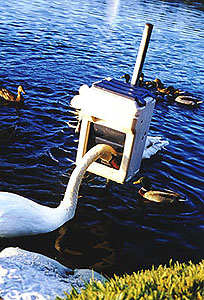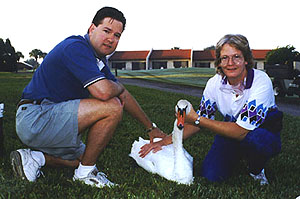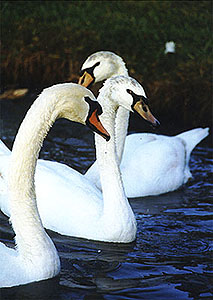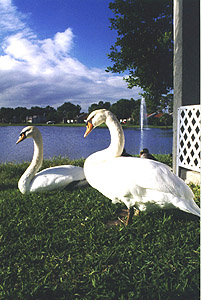To Save
A Swan
by
Shirley A. Bolin,
A.G.S. Fanchon F. Funk, Ed.D. Geoffrey R. Gardner, D.V.M.
Rebecca Webb Wilson, J.D. Sheila A. Bolin, M.S.
In the early morning mist, the rising sun
throws its rays onto gleaming white feathers. Two by two, the
birds ply through the water, barely causing a ripple. In line,
as if toy soldiers, they parade up and down the banks searching
for food. These magnificent creatures are English Mute Swans
and they are finding more than food beneath the water's surface.
Below lies a silent killer waiting for its next victim. The killer?
Botulism.
'A native of Europe and Asia, the English
Mute Swan was originally introduced into the United States in
New York's Hudson River Valley during the 19th century. The English
Mute is a protected species in England because of its royal lineage.
Many of the swans are direct descendants of swans raised and
bred from Her Majesty The Queen's Royal stock, dating back to
the 12th century.' (The Regal Swan,
2000). From the winding shores of the Thames River, to the lakes
and ponds of Florida and the Southeastern United States, in some
cases, this magnificent bird is dying from botulism, lead poisoning,
predators and random acts of violence.
Indigenous neither to Florida nor the south
eastern United States, English Mute Swans are being introduced
to hot and sometimes hostile climates to adorn ponds and lakes.
These bodies of water, many of which are man-made, are scattered
throughout resorts, hotels, motels, recreation facilities and
theme parks. Information available to many property owners regarding
how to raise and maintain these creatures is limited at best.
Although most people are aware that the swans need to be fed,
they may feed them only bread which can cause deficiencies in
their diet and lead to a variety of health problems.
In areas where ponds or lakes are highly
maintained, such as golf courses or other public facilities,
the swans may not have enough food to survive. The swans' diet
must be supplemented using a feed mix consisting of cracked corn
and laying poultry pellets or crumbles. The birds are fed out
of a Blitz® USA automatic dog feeder mounted on a pole in
the water so that other animals cannot get into the food. The
food must be checked on a regular basis because a mold may grow
in the food which can sicken or kill the birds.
 The Blitz® Automatic Dog Feeder.
The Blitz® Automatic Dog Feeder.
Photo by Rebecca Webb Wilson©.
Lead poisoning continues to be a danger
to swans as well as other waterfowl due to the ingestion of lead
fishing sinkers. Predators of swans in the south eastern United
States include alligators, otters, foxes, and in the case of
baby swans (cygnets), blue herons and egrets. Mankind remains
the most unpredictable predator with many acts of violence and
theft reported each year.
However, the swans' worst enemy appears
to be botulism. Botulism knows no barriers. It is found in England,
Florida and the south eastern United States and kills both captive
and wild swans. 'It is estimated that millions of birds die annually.
Botulism management is an international concern,' according to
Ducks Unlimited in Canada. Avian botulism is known to affect
all waterfowl including ducks, pelicans, geese and swans.
'Many swans die from botulism during the
summer months when temperatures increase causing a blue-green
algae to grow in the water,' stated Mr. David Barber, Swan Marker
To Her Majesty The Queen. The neurotoxin strikes quickly, and
in most cases, there is little that can be done. However, some
affected birds have been treated with intensive therapy support,'
according to Ms. Dot Beeson, Founder and Mr. Steve Knight, Trustee
of the Swan Sanctuary in Egham, England.
Botulism is a neurotoxin given off by the
bacterium Clostridium Botulinum. There are six main types of
toxins produced, only two of which, types A and C, are believed
to cause disease in birds. The toxins are released by the bacteria
found in dead and decaying plant or animal matter in the muck
found in the lake bottom. The signs of botulism are a flaccid
paralysis of the skeletal musculature, especially the neck and
tongue. This is the reason for the common name of the disease,
'limberneck.' Treatment is expensive and often not effective.
If the muscles that control breathing are also paralyzed, death
quickly results. Prevention of the deadly disease is the method
currently used by Florida Veterinarian, Geoffey R. Gardner, D.V.M.
Dr. Gardner, of the Lakeland Veterinary
Hospital, is responsible for the care of the swans for the City
of Lakeland, a flock numbering nearly 200 birds, as well as many
of the swans that need care in the Central Florida area. 'The
value of preventing botulism has been evident over the years.
This is a situation where an ounce of prevention is really worth
a pound of cure,' says Gardner. Previously, his father, Wade
Gardner, D.V.M., was the caretaker for the Lakeland flock which
included a mating pair of swans donated to Lakeland by Her Majesty
Queen Elizabeth II.
 Dr. Geoffrey Gardner and Sheila
Bolin with one of the swans at Orange Lake Resort &
Dr. Geoffrey Gardner and Sheila
Bolin with one of the swans at Orange Lake Resort &
Country Club in Orlando, Florida. The photo was taken by Shirley
Bolin©.
During Dr. Wade Gardner's 40 year tenure,
he became a pioneer in documenting, diagnosing and treating a
variety of conditions in the Lakeland swans. In the early 80's,
botulism nearly wiped out the Lakeland swan population. Dr. Wade
Gardner began innoculating the swans against botulism. For over
20 years, his method of botulism prevention has been successfully
used and losses of birds in recent years to botulism has been
mitigated. For more than a decade, Dr. Geoffrey Gardner has carried
on the task of using a vaccine to routinely protect the entire
flock from the threat of botulism.
Led by Dr. Geoffrey Gardner, a project
team has been formed to document and research Dr. Wade Gardner's
work with the swan vaccinations. Rhinosporodium which causes
a fungal eye infection in the birds from inferior water quality
will also be studied. This fungus can be treated with an antibiotic
opthalmalic solution. 'A large number of swan owners/keepers
are not aware of the need for routine health checks by a licensed
veterinarian who is trained to detect early signs of disease,'
according to Dr. Geoffrey Gardner. ' It is essential that a practical
knowledge base be accessible for individuals wishing to raise
and maintain the animals.'
 An adult English Mute swan with
two cygnets
An adult English Mute swan with
two cygnets
approximately 8 months of age at Orange Lake Resort & Country
Club.
The photo was taken by Rebecca Webb Wilson©.
'The Regal Swan Project,' is being supported by Kemmons Wilson, Founder
of Holiday Inn® and developer of Orange Lake Resort & Country Club in
Orlando, Florida. Wilson and his son, Spence, Chairman of the
Board of Orange Lake Resort & Country Club, hope that this
important research project changes the way the birds are raised
and bred. The information gathered will be used to help increase
the bird's survival rate and ensure the continuation of its royal
lineage for future generations. Data gathered will appear in
book form in 'The Regal Swan' (2000). Other sponsors include:
Blitz® USA, Lakeland Veterinary Hospital, American Camper,
The Sports Authority, Cobra Electronics and Timex®.
Historical information is being provided by The
Royal Windsor Website by ThamesWeb which is devoted to stories
and histories about the town of Windsor, England. "ThamesWeb's
help has been invaluable. They have provided personal insight
into the history of the English Mute Swan, giving us color background
for the book, to which we might not otherwise have had access.
And last, but certainly not least, ThamesWeb has helped to pave
the way for contact between the research team and England's swan
providers," explains Sheila Bolin, M.S., Orange Lake's swan
keeper.
Team members of the 'Regal Swan Project' include: Geoffrey
R. Gardner, D.V.M., Lakeland Veterinary Hospital; Sheila A. Bolin,
M.S., Orange Lake's swan keeper; Fanchon F. Funk, Ed.D., Associate
Professor, Florida State University; Rebecca Webb Wilson, J.D.,
Professional Photographer and Lifetime Trustee of the Memphis
Zoological Society, Memphis, Tennessee; and Shirley A. Bolin,
A.G.S., Orange Lake's Head Photographer.
For further information on the 'Regal Swan Project', contact Sheila Bolin,
Orange
Lake Resort & Country Club (Email: Bolin.S@att.net)
or tel: (407) 239-2292 or Dr. Geoffrey Gardner at (941) 665-1811.

To contact us, email
Thamesweb.
|


